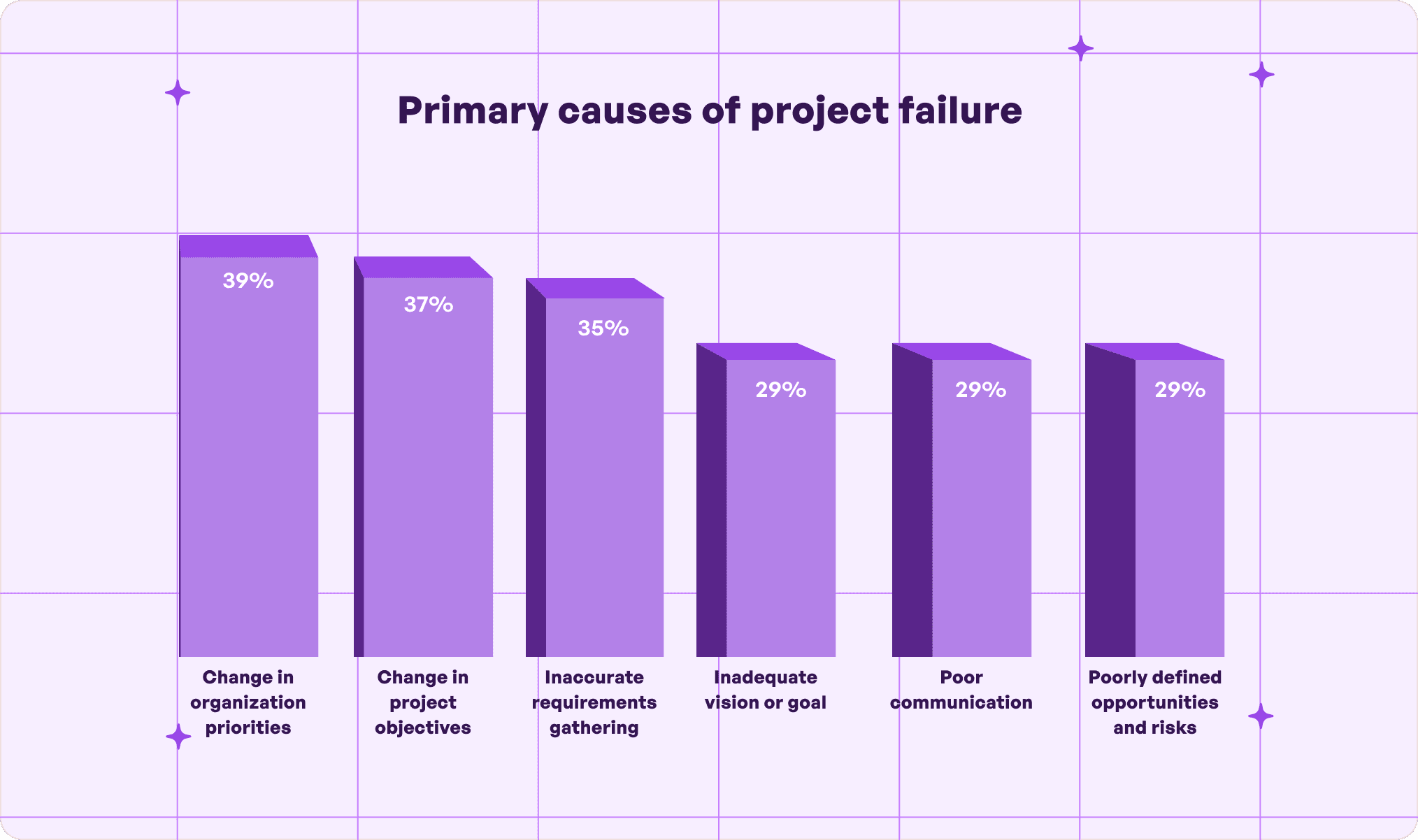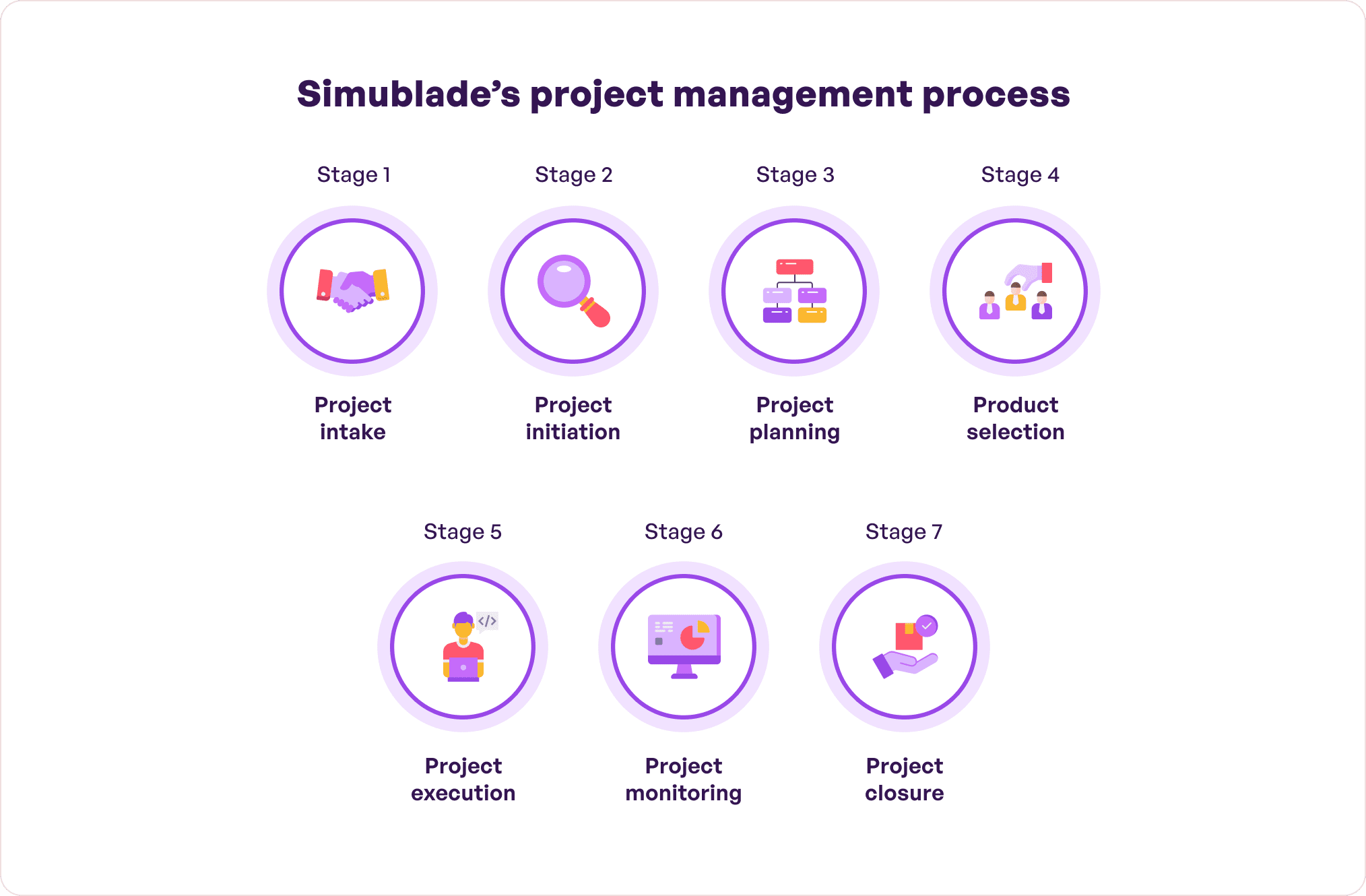Every software development process starts with a clearly defined scope of work, timelines, objectives, budget, and milestones. However, only 16% of the projects end on time. But why is the success rate low after a structured process? Well, while sometimes it is because the development agency struggles with managing multiple projects. On other times, it can be clients-driven with them requesting new features addition or extending the feedback timeline.
The outcome in both the instances is the same – delayed go-to-market time and a probability of losing users’ interest to competitors.
In a space where ‘launch fast! fail fast!’ has become the primary mode of operation, it is critical for businesses to identify and overcome every project failure risk much before the full-fledged launch is due.

Having worked on over 150+ digital solutions across a range of industries like Fintech, eCommerce, crypto-based applications, and social media, we at Simublade, have aced the project management approach.
Here is the validation.
- Every single one of the 100+ software have been delivered on time and in budget
- Our clients have raised over $700 million in funding
- 4.8/5.0 average client rating on development and delivery experience.
In this article, we are going to dive into our project management methodologies that have helped achieve these numbers along with other factors like the project management tools we work with and how we tackle the typical challenges that emerge in project development.
Table of contents
The common types of project management methodologies
Below is a list of methodologies , which are basically sets of principles, that are commonly used in various project management processes. The developers usually analyze your project well to be able to pick the best suited approach. Here’s a look:
Agile methodology
This project management approach is not rigid and breaks down the project in short sprints. An example of an Agile framework is Scrum which is a popular product management tool. The top benefit of this is better risk management, higher visibility and predictability, and improved quality.
Lean methodology
The work is distributed in any method without strict rules that will add value to clients. The main idea here is to eliminate any client dissatisfaction and ensure the highest standards of efficiency and productivity.
Waterfall methodology
This is a linear project management approach where all information is gathered in the beginning and then a fixed development sequence is established. The project does not progress if the previous stages are incomplete. The top benefit of this is a clear structure with time and cost without confusions and doubts.
What is the 7-step project management process that Simublade follows?
Whether you are developing software or building a car, the five steps of the project management life cycle witnesses limited changes. The phases’ outcome might vary due to the different project type, yet the main objective and end outcome remain the same.
Project management can be tricky but nothing is impossible with a structured approach. So, hire developers like us who follow a streamlined process as below.

Step 1: Project intake
In this stage of project management, a rough outline of the project is created which helps to determine if the purpose of the project is to solve the pre-defined problem. Further, experts also verify whether the required human resources are available to deliver the expected results.
Step 2: Project initiation
This is clearly the most critical stage of the agile project management methodology since the aim here is to find the purpose of the project or visualize the project and turn an idea into a goal. There are two distinct easy to do so:
S.M.A.R.T. – Specific, Measurable, Attainable, Realistic, and Timely.
C.L.E.A.R. – Collaborative, Limited, Emotional, Appreciable, and Refinable.
Another critical thing to do here is research its viability on both market and technical grounds. The best way to perform this stage and understand these is by outlining the project needs against the business goals and preferred outcomes. This is done in 3 documents:
Business case: This talks about the project importance, objectives, and ROI.
Project character: This ensures that the project can be completed within a reasonable pricing and timeline.
Feasibility study: This defines what the project will deliver, that is, the outcome.
Step 3: Project planning
At this stage, we lay out every single detail of your project which goes on to become the foundation of the entire project development cycle.
We start this phase by preparing the project scope on a work breakdown structure document that highlights tasks and identifies technical requirements and the efforts that would go in performing them. Additionally, the document also contains information around tasks, resources, responsibilities, timelines, approval process, and deadlines to be followed.
It is at this point that we also decide on the project management tools we will use. Further, the stakeholder management, risk management, and scope management plans are laid down to avoid bottlenecks down the line.
Step 4: Product selection
This is a strategic phase where the IT software is analyzed and procured. Our team ensures that the chosen product is well-aligned with the business and project end goals.
Step 5: Project execution
This is the lengthiest phase of all project management methodologies since it is where design and development happens as per the product roadmaps developed in the previous stages. Our team has a grasp on important business domains like technical, business, and generalist which helps them in collaborating, performing tasks, presenting them via weekly builds, and working on the edits.
While the design and development teams work on the actual execution, the project manager that we allocate to your software would work on –
- Budget and timeline management
- Resource planning
- Change management
- Quality management
- Internal review of deliverables
- Meetings and communication facilitation.
In order to manage it all successfully, we make it our modus operandi to follow the project scope to its last detail. At the same time, we have two mandatory meetings –
- Daily meeting on team check-in and status update
- Post build release meeting on timeline and budget reviews.
At every stage we ensure that you are updated on how the project is moving, if there are any roadblocks, and the budget and resources details are provided.
Step 6: Project monitoring
This stage of the agile project management process deals with ensuring that the project is running smoothly and everything is aligned with the initially planned scope of work under quality assurance sessions. This is done by establishing Critical Success Factors (CSF) and Key Performance Indicators (KPI). As a part of this stage, we also keep an eye on –
Up until this point, every stage of the project development cycle involves you. Right from the conceptualization stage to execution and monitoring, you take the front seat in terms of how the project is progressing.
Step 7: Project closure
This stage is internal in nature and the last stage of the project activity. When we close a project, we don’t just directly move to the next software development, we celebrate the success and retrospect the elements which could have been made better.
On that aspect, every project is followed by a one-pager that contains details of –
- Project name
- Pre-decided goals
- Date of initiation
- Promised deadline vs actual deadline
- Project budget vs actual budget
- Team members and stakeholders involved
- Project challenges and win.
Now that we have looked at the different aspects of how our project management team takes care of your project management software development and launch project, it is equally important to focus on the challenges we come across and the way we address them to ensure our relationship with the client remains strong.
As we close this article, let us look into the challenges our Simublade project management team encounter and some ways they solve them.
The project management challenges we encounter
While it is known that every development project comes with its own set of unique technical or operational challenges, the issues around project management however, are fairly predictable. Here are some of the challenges we have faced in our history of being digital product development partners of both startups and enterprises.
Too many priority items
One of the most commonly arising issues for us is multiple items becoming top priority. At times, clients take feedback from other stakeholders and come back with an urgency on re-prioritizing tasks.
The way we approach this is by:
- First, seeing if there is a scope in the current sprint to accommodate the change.
- Second, if not, we discuss the priority serialization with the clients again and help them understand the effects of priority changes on the development timeline.
Scope creep
Project scope creep usually happens when new features start getting added in the development cycle frequently. The issue with these changes can be seen in the project being at risk of late completion, exceeding the scope, over budgeting and lack in quality.
The solution to this is treating the project scope as Bible and being transparent with the clients about the impact on their budget and timelines.
Last-minute budget changes
Sometimes the client tells us mid-way that they have a much lower budget than they originally anticipated for the project development. In such cases, we sit with our clients to discuss the new scope of work while ensuring that Simublade project developers team leave no stones unturned in guaranteeing high quality standards.
Conclusion
With this, we are sure you must have gotten an idea of how we approach project management. The end goal for us is ultimately to maintain complete transparency and ensure collaboration within the internal and external stakeholders. And how do we achieve this ? By using the right project management software and a team that has an experience of working with multiple projects with their own set of complexities.
FAQs
Q. What are the 7 phases of project management?
Ans. The 7 project management phases are project intake, project initiation, project planning, product selection, product execution, product monitoring, and project closure.
Q. What is the project life cycle?
Ans. Project life cycle includes 5 core phases: initiation, planning, execution, monitoring, and closure. Altogether, these are called lifecycle which is an umbrella term for the order of these stages for a project.
Q. What is the difference between project management and project life cycle?
Ans. Project management defines the scope and stages of the project. Project life cycle means executing methodologies and frameworks to accomplish the work.
Q. What is the role of the project manager?
Ans. At Simublade, our project managers help with everything, from portfolio management to strategic planning through a lean front-line execution, to build a future-ready product.





